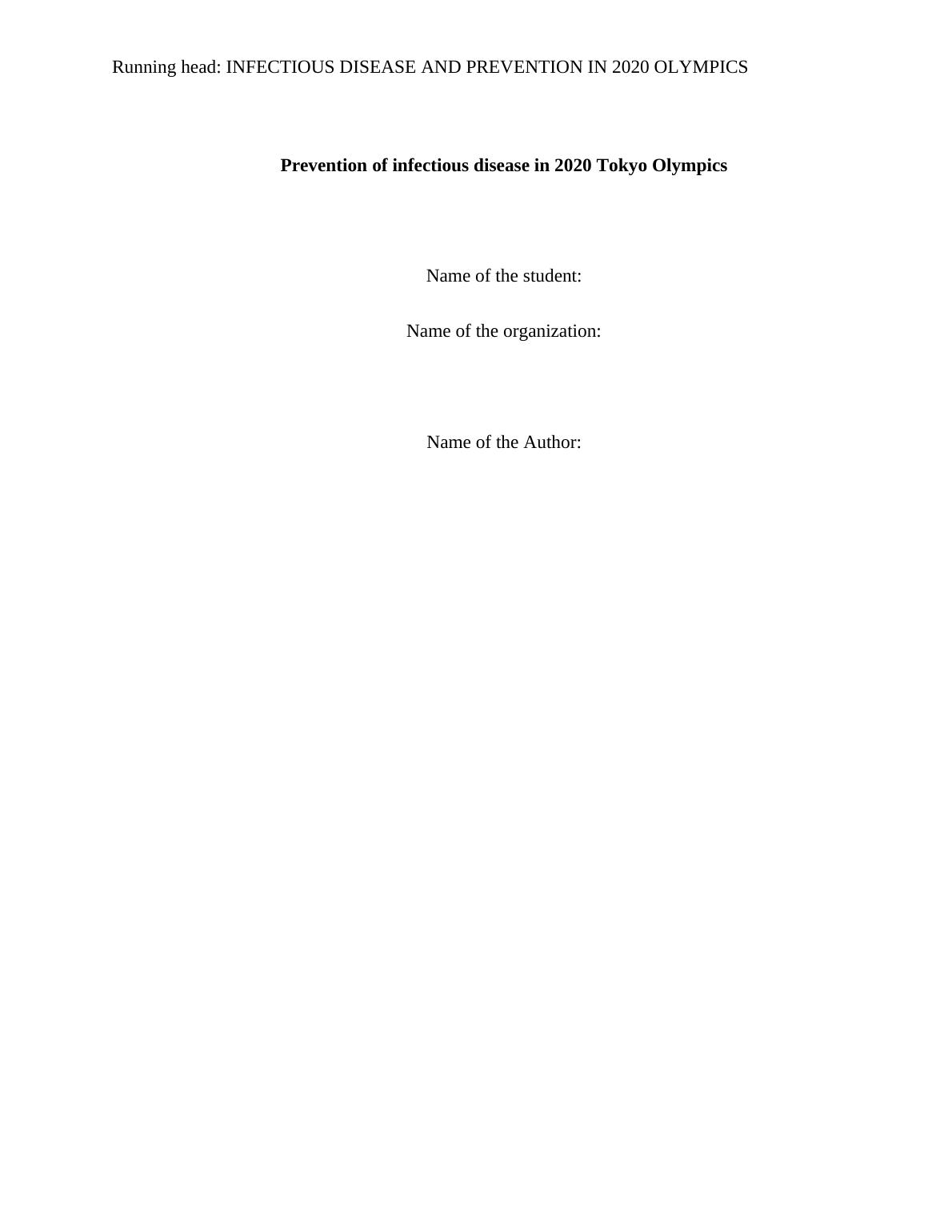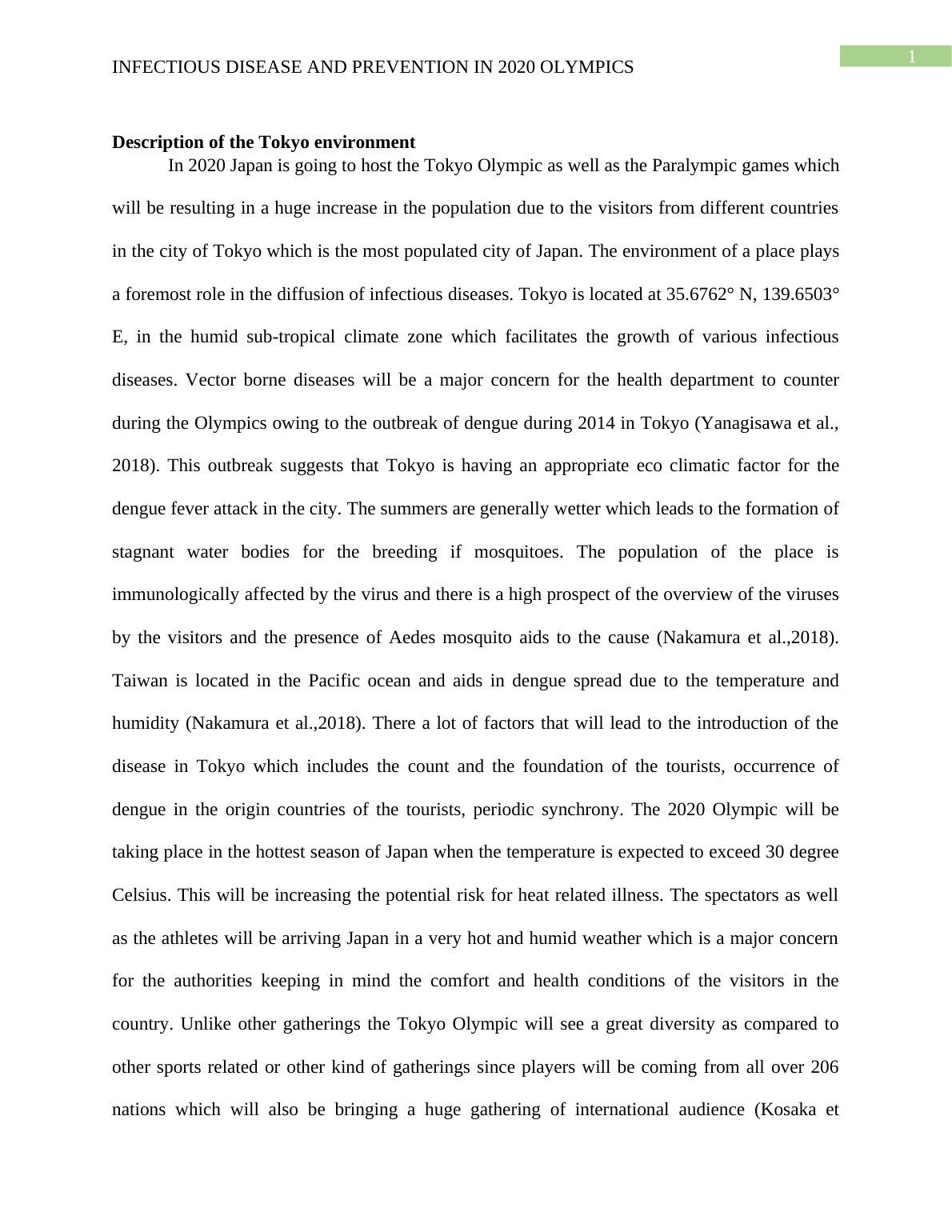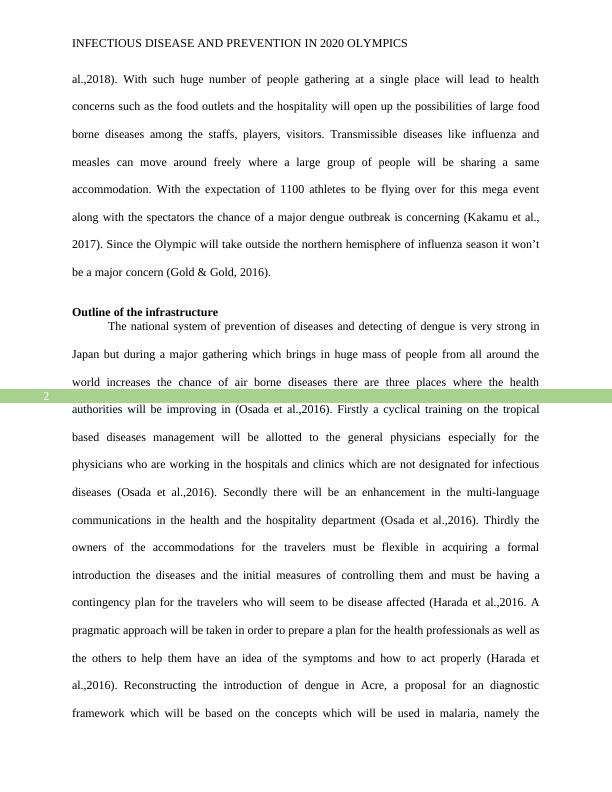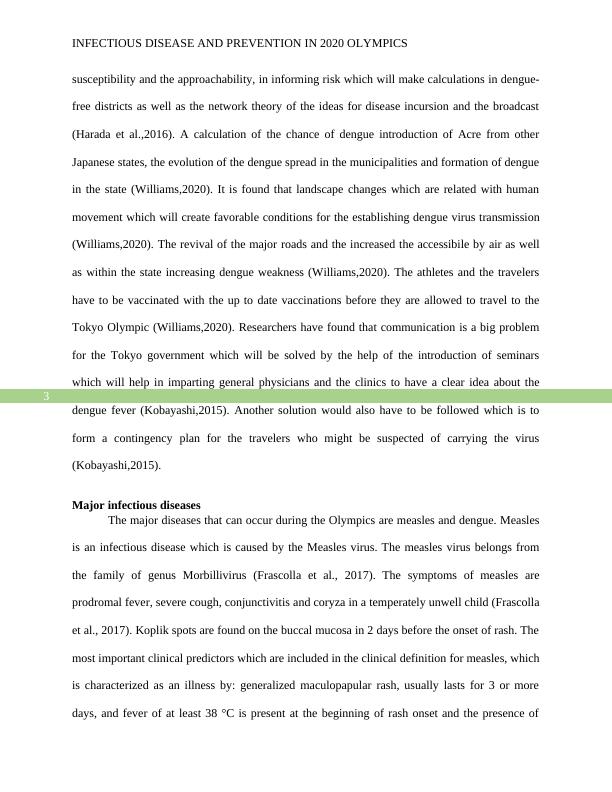Assignment | INFECTIOUS DISEASE AND PREVENTION IN 2020 OLYMPICS
Added on 2022-10-04
11 Pages3569 Words20 Views
Running head: INFECTIOUS DISEASE AND PREVENTION IN 2020 OLYMPICS
Prevention of infectious disease in 2020 Tokyo Olympics
Name of the student:
Name of the organization:
Name of the Author:
Prevention of infectious disease in 2020 Tokyo Olympics
Name of the student:
Name of the organization:
Name of the Author:

1
INFECTIOUS DISEASE AND PREVENTION IN 2020 OLYMPICS
Description of the Tokyo environment
In 2020 Japan is going to host the Tokyo Olympic as well as the Paralympic games which
will be resulting in a huge increase in the population due to the visitors from different countries
in the city of Tokyo which is the most populated city of Japan. The environment of a place plays
a foremost role in the diffusion of infectious diseases. Tokyo is located at 35.6762° N, 139.6503°
E, in the humid sub-tropical climate zone which facilitates the growth of various infectious
diseases. Vector borne diseases will be a major concern for the health department to counter
during the Olympics owing to the outbreak of dengue during 2014 in Tokyo (Yanagisawa et al.,
2018). This outbreak suggests that Tokyo is having an appropriate eco climatic factor for the
dengue fever attack in the city. The summers are generally wetter which leads to the formation of
stagnant water bodies for the breeding if mosquitoes. The population of the place is
immunologically affected by the virus and there is a high prospect of the overview of the viruses
by the visitors and the presence of Aedes mosquito aids to the cause (Nakamura et al.,2018).
Taiwan is located in the Pacific ocean and aids in dengue spread due to the temperature and
humidity (Nakamura et al.,2018). There a lot of factors that will lead to the introduction of the
disease in Tokyo which includes the count and the foundation of the tourists, occurrence of
dengue in the origin countries of the tourists, periodic synchrony. The 2020 Olympic will be
taking place in the hottest season of Japan when the temperature is expected to exceed 30 degree
Celsius. This will be increasing the potential risk for heat related illness. The spectators as well
as the athletes will be arriving Japan in a very hot and humid weather which is a major concern
for the authorities keeping in mind the comfort and health conditions of the visitors in the
country. Unlike other gatherings the Tokyo Olympic will see a great diversity as compared to
other sports related or other kind of gatherings since players will be coming from all over 206
nations which will also be bringing a huge gathering of international audience (Kosaka et
INFECTIOUS DISEASE AND PREVENTION IN 2020 OLYMPICS
Description of the Tokyo environment
In 2020 Japan is going to host the Tokyo Olympic as well as the Paralympic games which
will be resulting in a huge increase in the population due to the visitors from different countries
in the city of Tokyo which is the most populated city of Japan. The environment of a place plays
a foremost role in the diffusion of infectious diseases. Tokyo is located at 35.6762° N, 139.6503°
E, in the humid sub-tropical climate zone which facilitates the growth of various infectious
diseases. Vector borne diseases will be a major concern for the health department to counter
during the Olympics owing to the outbreak of dengue during 2014 in Tokyo (Yanagisawa et al.,
2018). This outbreak suggests that Tokyo is having an appropriate eco climatic factor for the
dengue fever attack in the city. The summers are generally wetter which leads to the formation of
stagnant water bodies for the breeding if mosquitoes. The population of the place is
immunologically affected by the virus and there is a high prospect of the overview of the viruses
by the visitors and the presence of Aedes mosquito aids to the cause (Nakamura et al.,2018).
Taiwan is located in the Pacific ocean and aids in dengue spread due to the temperature and
humidity (Nakamura et al.,2018). There a lot of factors that will lead to the introduction of the
disease in Tokyo which includes the count and the foundation of the tourists, occurrence of
dengue in the origin countries of the tourists, periodic synchrony. The 2020 Olympic will be
taking place in the hottest season of Japan when the temperature is expected to exceed 30 degree
Celsius. This will be increasing the potential risk for heat related illness. The spectators as well
as the athletes will be arriving Japan in a very hot and humid weather which is a major concern
for the authorities keeping in mind the comfort and health conditions of the visitors in the
country. Unlike other gatherings the Tokyo Olympic will see a great diversity as compared to
other sports related or other kind of gatherings since players will be coming from all over 206
nations which will also be bringing a huge gathering of international audience (Kosaka et

2
INFECTIOUS DISEASE AND PREVENTION IN 2020 OLYMPICS
al.,2018). With such huge number of people gathering at a single place will lead to health
concerns such as the food outlets and the hospitality will open up the possibilities of large food
borne diseases among the staffs, players, visitors. Transmissible diseases like influenza and
measles can move around freely where a large group of people will be sharing a same
accommodation. With the expectation of 1100 athletes to be flying over for this mega event
along with the spectators the chance of a major dengue outbreak is concerning (Kakamu et al.,
2017). Since the Olympic will take outside the northern hemisphere of influenza season it won’t
be a major concern (Gold & Gold, 2016).
Outline of the infrastructure
The national system of prevention of diseases and detecting of dengue is very strong in
Japan but during a major gathering which brings in huge mass of people from all around the
world increases the chance of air borne diseases there are three places where the health
authorities will be improving in (Osada et al.,2016). Firstly a cyclical training on the tropical
based diseases management will be allotted to the general physicians especially for the
physicians who are working in the hospitals and clinics which are not designated for infectious
diseases (Osada et al.,2016). Secondly there will be an enhancement in the multi-language
communications in the health and the hospitality department (Osada et al.,2016). Thirdly the
owners of the accommodations for the travelers must be flexible in acquiring a formal
introduction the diseases and the initial measures of controlling them and must be having a
contingency plan for the travelers who will seem to be disease affected (Harada et al.,2016. A
pragmatic approach will be taken in order to prepare a plan for the health professionals as well as
the others to help them have an idea of the symptoms and how to act properly (Harada et
al.,2016). Reconstructing the introduction of dengue in Acre, a proposal for an diagnostic
framework which will be based on the concepts which will be used in malaria, namely the
INFECTIOUS DISEASE AND PREVENTION IN 2020 OLYMPICS
al.,2018). With such huge number of people gathering at a single place will lead to health
concerns such as the food outlets and the hospitality will open up the possibilities of large food
borne diseases among the staffs, players, visitors. Transmissible diseases like influenza and
measles can move around freely where a large group of people will be sharing a same
accommodation. With the expectation of 1100 athletes to be flying over for this mega event
along with the spectators the chance of a major dengue outbreak is concerning (Kakamu et al.,
2017). Since the Olympic will take outside the northern hemisphere of influenza season it won’t
be a major concern (Gold & Gold, 2016).
Outline of the infrastructure
The national system of prevention of diseases and detecting of dengue is very strong in
Japan but during a major gathering which brings in huge mass of people from all around the
world increases the chance of air borne diseases there are three places where the health
authorities will be improving in (Osada et al.,2016). Firstly a cyclical training on the tropical
based diseases management will be allotted to the general physicians especially for the
physicians who are working in the hospitals and clinics which are not designated for infectious
diseases (Osada et al.,2016). Secondly there will be an enhancement in the multi-language
communications in the health and the hospitality department (Osada et al.,2016). Thirdly the
owners of the accommodations for the travelers must be flexible in acquiring a formal
introduction the diseases and the initial measures of controlling them and must be having a
contingency plan for the travelers who will seem to be disease affected (Harada et al.,2016. A
pragmatic approach will be taken in order to prepare a plan for the health professionals as well as
the others to help them have an idea of the symptoms and how to act properly (Harada et
al.,2016). Reconstructing the introduction of dengue in Acre, a proposal for an diagnostic
framework which will be based on the concepts which will be used in malaria, namely the

3
INFECTIOUS DISEASE AND PREVENTION IN 2020 OLYMPICS
susceptibility and the approachability, in informing risk which will make calculations in dengue-
free districts as well as the network theory of the ideas for disease incursion and the broadcast
(Harada et al.,2016). A calculation of the chance of dengue introduction of Acre from other
Japanese states, the evolution of the dengue spread in the municipalities and formation of dengue
in the state (Williams,2020). It is found that landscape changes which are related with human
movement which will create favorable conditions for the establishing dengue virus transmission
(Williams,2020). The revival of the major roads and the increased the accessibile by air as well
as within the state increasing dengue weakness (Williams,2020). The athletes and the travelers
have to be vaccinated with the up to date vaccinations before they are allowed to travel to the
Tokyo Olympic (Williams,2020). Researchers have found that communication is a big problem
for the Tokyo government which will be solved by the help of the introduction of seminars
which will help in imparting general physicians and the clinics to have a clear idea about the
dengue fever (Kobayashi,2015). Another solution would also have to be followed which is to
form a contingency plan for the travelers who might be suspected of carrying the virus
(Kobayashi,2015).
Major infectious diseases
The major diseases that can occur during the Olympics are measles and dengue. Measles
is an infectious disease which is caused by the Measles virus. The measles virus belongs from
the family of genus Morbillivirus (Frascolla et al., 2017). The symptoms of measles are
prodromal fever, severe cough, conjunctivitis and coryza in a temperately unwell child (Frascolla
et al., 2017). Koplik spots are found on the buccal mucosa in 2 days before the onset of rash. The
most important clinical predictors which are included in the clinical definition for measles, which
is characterized as an illness by: generalized maculopapular rash, usually lasts for 3 or more
days, and fever of at least 38 °C is present at the beginning of rash onset and the presence of
INFECTIOUS DISEASE AND PREVENTION IN 2020 OLYMPICS
susceptibility and the approachability, in informing risk which will make calculations in dengue-
free districts as well as the network theory of the ideas for disease incursion and the broadcast
(Harada et al.,2016). A calculation of the chance of dengue introduction of Acre from other
Japanese states, the evolution of the dengue spread in the municipalities and formation of dengue
in the state (Williams,2020). It is found that landscape changes which are related with human
movement which will create favorable conditions for the establishing dengue virus transmission
(Williams,2020). The revival of the major roads and the increased the accessibile by air as well
as within the state increasing dengue weakness (Williams,2020). The athletes and the travelers
have to be vaccinated with the up to date vaccinations before they are allowed to travel to the
Tokyo Olympic (Williams,2020). Researchers have found that communication is a big problem
for the Tokyo government which will be solved by the help of the introduction of seminars
which will help in imparting general physicians and the clinics to have a clear idea about the
dengue fever (Kobayashi,2015). Another solution would also have to be followed which is to
form a contingency plan for the travelers who might be suspected of carrying the virus
(Kobayashi,2015).
Major infectious diseases
The major diseases that can occur during the Olympics are measles and dengue. Measles
is an infectious disease which is caused by the Measles virus. The measles virus belongs from
the family of genus Morbillivirus (Frascolla et al., 2017). The symptoms of measles are
prodromal fever, severe cough, conjunctivitis and coryza in a temperately unwell child (Frascolla
et al., 2017). Koplik spots are found on the buccal mucosa in 2 days before the onset of rash. The
most important clinical predictors which are included in the clinical definition for measles, which
is characterized as an illness by: generalized maculopapular rash, usually lasts for 3 or more
days, and fever of at least 38 °C is present at the beginning of rash onset and the presence of

End of preview
Want to access all the pages? Upload your documents or become a member.
Related Documents
Infectious Disease Prevention And Managementlg...
|13
|3014
|32
2020 Summer Olympics in Tokyo Report 2022lg...
|11
|2800
|57
Disease Prevention and Management Research Paper 2022lg...
|11
|3125
|36
